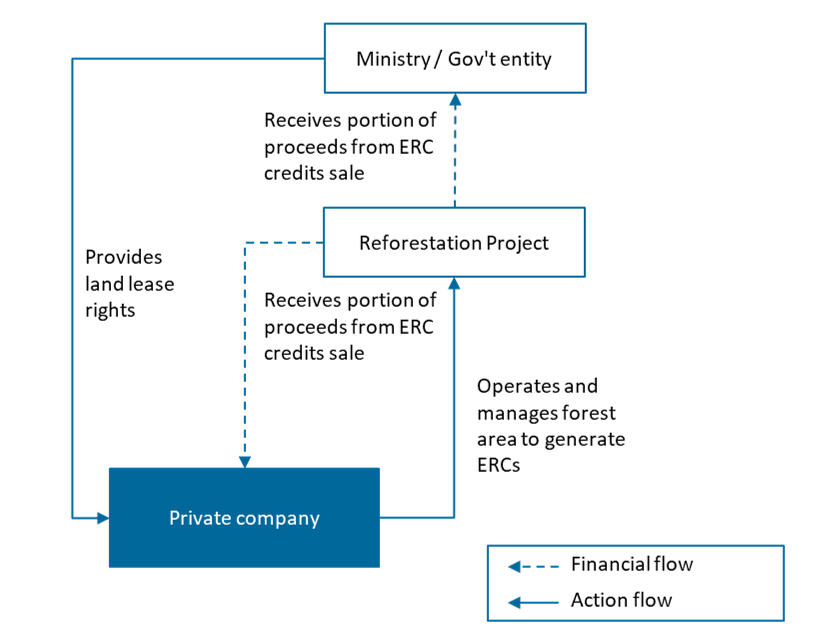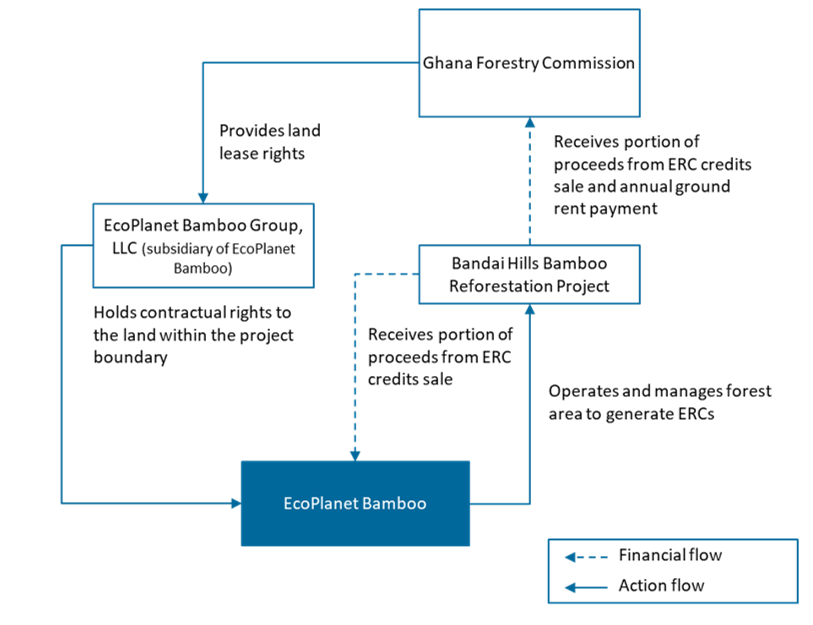Reforestation Program Model for ERP

Photo Credit: Image by Freepik
On this page: Reforestation Program leveraging a New-Finance-Bulk-Tariffs model - Model 12 in the ERP Project Guidelines. Read more below, or visit Strategic Guidance for Country System Assessments, Guidance for Countries in Assessing ERC Projects, or Mobilizing ERC Finance.
Project Type: Afforestation, Reforestation and Regeneration
Sector: Forestry
Applicable Project Methodology: Afforestation of degraded land, AR-ACM0003 - Afforestation and reforestation of lands except wetlands
This project type targets reforestation and afforestation efforts for forest areas that are currently highly degraded, making them susceptible to further depletion of the existing tree cover.
The project will be leveraging a New-Finance-Bulk-Tariffs model. An experienced forestry operator is provided a long-term lease by the government or state-owned entity to take over management of the forested area. The private sector entity will be financing operations and recovering its investments through the sale of the by-products of the afforestation activity (e.g. bamboo), as well as through the emission reduction credits (ERCs) generated and sold in the voluntary carbon markets. Table 1: Model Attributes Business New This model assumes that the government or state-owned entity grantor will be authorizing a new long-term lease to the project company to take over the management of the forest area. Existing Construction Build The project involves the operational and monitoring services from the project company. Refurbish Private Funding Finance The project company will be charged with raising financing for the management of the forest area. Service Bulk Revenues of the project company will be sourced from contracted bulk purchasers of the forest’s by-products User Service Fees Revenues in this model will be driven by the tariffs paid to the project company for the by-products produced by the forest. Tariffs Proposed risk allocation of the Public Private Partnership Model Key features of PPP structure Key considerations/risks for proposed project Expected ERC end use Figure 1: Financing and Activity Flows for the Model Project description The Bandai Hills Bamboo Reforestation Project is a reforestation project that is restoring 7,818 hectares (ha) of degraded forest lands within the Ashanti Region of Ghana, West Africa. It is a carbon financed project that integrates the reforestation of 1.5 million (M) seedlings of sympodial bamboo with remnant standing trees, and areas set aside for biodiversity and conservation. The project area has suffered extreme historical deforestation and represents highly degraded lands that are prone to further loss of remaining tree cover in the absence of the reforestation activity. Targeted results Expected annual ERCs generated from the program will be 188,926 tonnes. Figure 2: Structure of Case Study PPP EcoPlanet Bamboo, the project proponent, operates a PPP with the Government of Ghana, via the Ghana Forestry Commission. The project proponent, EcoPlanet Bamboo, through its subsidiary, EcoPlanet Bamboo Group, LLC holds the contractual right to the land within the project boundary, the bamboo to be planted, and associated greenhouse gas (GHG) emission removals. Within the terms of the Land Lease Agreement, EcoPlanet Bamboo holds the legal right to control and operate program activities, as well as to all and any GHG emission removals generated by the project during the crediting period. The Ghana Forestry Commission are involved and consulted at all stages of its design and implementation of the project and benefits from an annual Ground Rent payment. The project’s Net Present Value (NPV) without ERC in- and outflows – only considering non-ERC inflows through other revenue streams or cost savings enabled by the project – is negative at - $3.95M13. With ERC cashflows, the project will have a positive NPV of $1.61M, which demonstrates the need for such nature-based removal projects to generate ERCs, as non-ERC cashflows alone is not financially viable. Table 2: Summary of sources of inflows and outflows and key assumptions ERC revenues or inflows Average Verified Carbon Standard (VCS) price of forestry (removal) project in Africa from Allied Offsets database (2022) Non-ERC revenues or inflows Estimated revenue of bamboo clums per hectare in Ghana by Akoto et al. (2020) Investment cost Breakdown of bamboo agroforestry development cashflows in Ghana by Akoto et al. (2020) Project implementation Breakdown of bamboo agroforestry development cashflows in Ghana by Akoto et al. (2020) ERC generation VCS Program Fees Table 3: Net cashflows summary (in USD) ERC Component Revenues/Inflows 0 75,157,113 75,157,113 Costs/Outflows -10,000 -391,501 -401,501 Net value -10,000 74,765,612 74,755,612 Primary/Non-ERC Component Revenues/Inflows 0 37,500,000 37,500,000 Costs/Outflows -5,070,000 -39,000,000 -44,070,000 Net value -5,070,000 -1,500,000 -6,570,000 Net Present Values NPV $1,614,095 NPV (ERC Component) $5,565,182 NPV (Non-ERC Component) -$3,951,087Proposed Structure of this Public Private Partnership (PPP) Model
Dimension
Attribute
Description


Case study: Bandai Hills Bamboo Reforestation Project, Ghana

Summary of the model financials
Value component
Assumptions
Sources
Components
Sum of initial outlays
Sum of in- or outflows from crediting period
Total cashflow
This section is intended to be a living document and will be reviewed at regular intervals. The Guidelines have not been prepared with any specific transaction in mind and are meant to serve only as general guidance. It is therefore critical that the Guidelines be reviewed and adapted for specific transactions. Unless expressly stated otherwise, the findings, interpretations, and conclusions expressed in the Materials in this Site are those of the various authors of the Materials and are not necessarily those of The World Bank Group, its member institutions, or their respective Boards of Executive Directors or member countries. For feedback on the content of this section of the website or suggestions for links or materials that could be included, please contact the PPPLRC at ppp@worldbank.org.
Updated: June 4, 2024
TABLE OF CONTENTS
UNLOCKING GLOBAL EMISSION REDUCTION CREDIT
Guidance for Countries in Assessing ERC Projects
1. Introduction to Emission Reduction Credits
• The World Bank's Emission Reduction Program
•Classification of Emissions Reduction Credit
• Policy Context of Emissions Reduction Credit
2. Objective of the Guidance for Countries in Assessing ERC Projects
• Objective of Project Preparation Guidelines
• Introduction to the Project Assessment Framework
• Process to Conducting Assessments
• S1: Green Economy Priorities
• S3: Article 6 Readiness and Eligibility
4. Conducting the Initial Profiling and Making a Preliminary Decision
• F2: Additional Value Enabled by Project
• C1, C2, and C3: Carbon Integrity and Environmental and Social Risk Management
5. Conducting the Project Assessment and Making the Final Decision
• F1: Project ERC value and F2: Additional Value Enabled by Project
• Q2: Marketing, Sales, and Pricing
• Q3: Project Governance and Structure
• C2: Environmental Risk Management
• C3: Social Risk Management and Benefits
6. Further Guidance for Application
• Country Context-driven Factors
• Considerations for Future Scope
Abbreviations: Guidance for Countries in Assessing ERC Projects
• B: Project Assessment Template
- Model 1: MRT Energy Efficiencies Model for ERP
- Model 2: Rural Electrification Model for ERP
- Model 4: Rooftop Solar Installation Model for ERP
- Model 5: LED Streetlight Deployment Model for ERP - for Specific Technologies
- Model 6: E-bus Deployment Model for ERP
- Model 7: EV Charging Systems Installation Model for ERP
- Model 8: Biodigesters Deployment Model for ERP
- Model 9: Waste-to-Power Model for ERP
- Model 10: Waste Treatment Facility Model for ERP
- Model 11: Climate Smart Farming Deployment Model for ERP
- Model 12: Reforestation Program Model for ERP